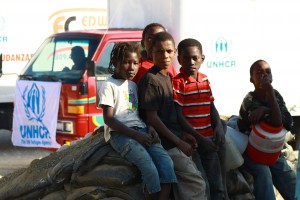January 3, 2010
The evaluation agency had reported neglect and lack of disaster preparedness in Haiti on behalf of donors and agenciesAs the world reels in shock at the sight of thousands of dead, injured and hungry Haitians, DARA experts, who had visited the Haiti various times within the context of the Humanitarian Response Index (HRI), had warned the international community that years of neglect and inadequate disaster preparedness had placed the country at risk of a major catastrophe. DARA is now urging the world to avoid committing the same errors that doomed past humanitarian relief efforts in Haiti.
The earthquake hit Haiti only months after DARA, denounced that aid efforts there in response to devastating storms in August and September of 2008 had failed to reach many of those in need. Donor response was so slow that 40 percent of the aid promised for storm recovery has yet to be delivered.

Haitian children sitting on a stone by the Peruvian UN MINUSTAH military border base at Cachiman as UNHCR convoy waits for escort. / UNHCR / J. Björgvinsson / March 2010
DARA calls for aid agencies and donor countries to go beyond immediate disaster aid and support middle to long-term recovery for Haiti’s population, as well as mainstreaming prevention and disaster risk reduction measures, something that has been neglected in past efforts.“The world’s generosity towards Haiti must not die off as soon as the last TV crew leaves the area,” said DARA spokesperson Silvia Hidalgo. “True generosity comes in the form of a sustained effort to help Haitians rebuild their homes and their society. The international community must also make sure that Haitians are equipped to handle disaster prevention in the future, and thus avoid such widespread death and destruction.”
The disaster struck when Haiti had not yet recovered from the effects of the hurricanes, which killed 800 people and left another 800,000 homeless. In its 2009 HRI, DARA concluded that inadequate disaster preparedness of local organizations, combined with broken infrastructures and insufficient funding and resources, contributed to the devastation and to the ultimate failure of the international community to alleviate the suffering of hundreds of thousands of Haitians who had lost everything.
DARA’s HRI also denounced that donors responding to recent disasters in Haiti have also largely failed to respect fundamental Principles and Good Practice Humanitarian Donorship (GHD), a set of guidelines that the world’s main donors have subscribed to but often ignore.
DARA recommends that donations be destined to those relief organizations already on the ground in Haiti. With an overwhelming amount of choices for the average citizen wanting to make a contribution, DARA suggests that people choose those agencies that have long-standing projects in Haiti. “This will ensure that every cent will to go to those most in need,” said Hidalgo.
Even before the earthquake hit, Haiti was already immersed in a critical socio-economic crisis that has placed it at the bottom of the economic ladder in the Western Hemisphere, with 80 percent of its population surviving on less than one dollar per day. This level of impoverishment, exacerbated by the effects of trade liberalization and combined with periodic natural disasters, has made it very difficult for Haitians to rebuild their society each time a disaster strikes.
Hidalgo, who participated in the Tsunami Evaluation Coalition (TEC) on behalf of DARA, also underlined the importance of involving Haitians in every step of the rebuilding and recovery process, a lesson learned from the post-Tsunami recovery period. “Involving local governments and NGO’s from the earliest stages of the process can help turn recovery into rehabilitation and sustainable development, and this means working on local capacity building from the start,” she said.
DARA also expressed concerns over ongoing access problems to victims of the catastrophe, particularly in poorer neighborhoods and outside Port-Au-Prince. According to the 2009 HRI, access to the neediest populations continues to be a prevalent problem when trying to provide post-crisis humanitarian aid.
As the aid reaches destroyed communities among much chaos, distribution in many areas has also been unequal, with much of it ending up in the hands of those who are first to reach the aid trucks, mostly young men. “In these situations it is often about the survival of the fittest, and organizations must make an extra effort to make sure that the aid also reaches the elderly, women and children, who are greatly suffering the impacts of the disaster,” said Hidalgo.
DARA experts also worry that the situation in Haiti could be replicated in other disaster-prone regions with fragile governments and infrastructure. “Katmandu is a place that comes to mind,” said Allan Lavell, an expert on urban planning who heads DARA’s Risk Reduction Index (RRI), a key project in the Disaster Risk Reduction Initiative (DRRI). “There, we also have a combination of extreme poverty, a highly seismic region and flimsy homes built on fragile slopes.”
Share this